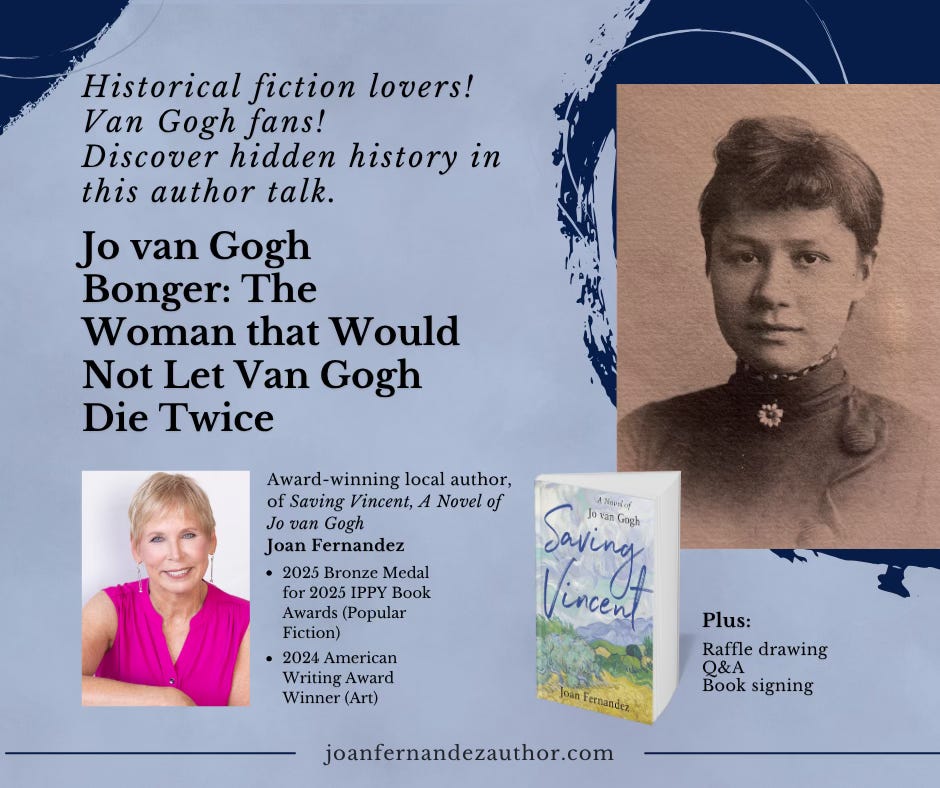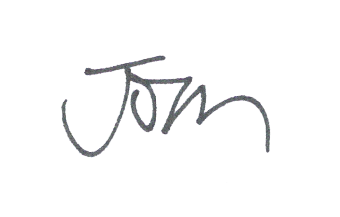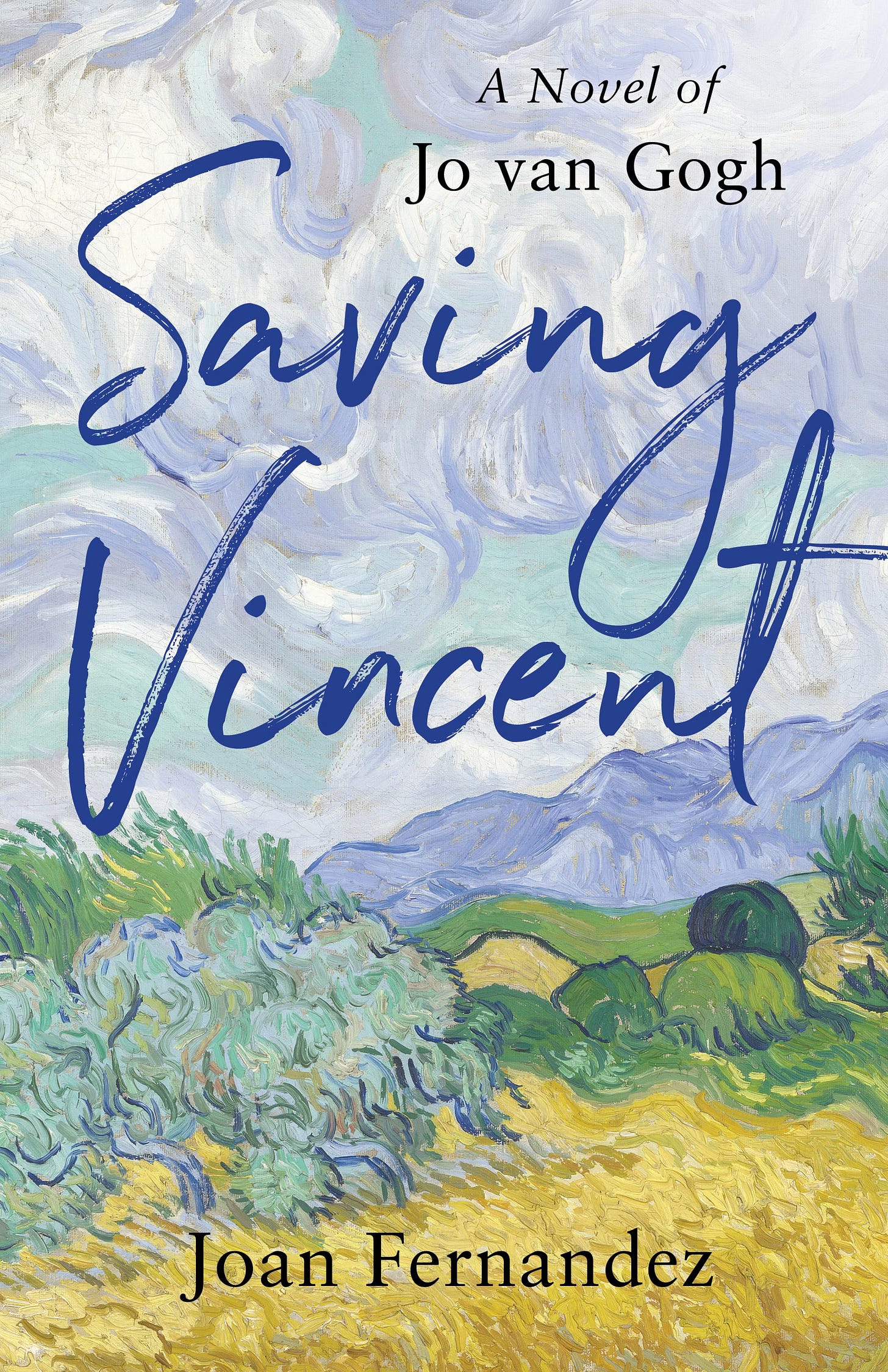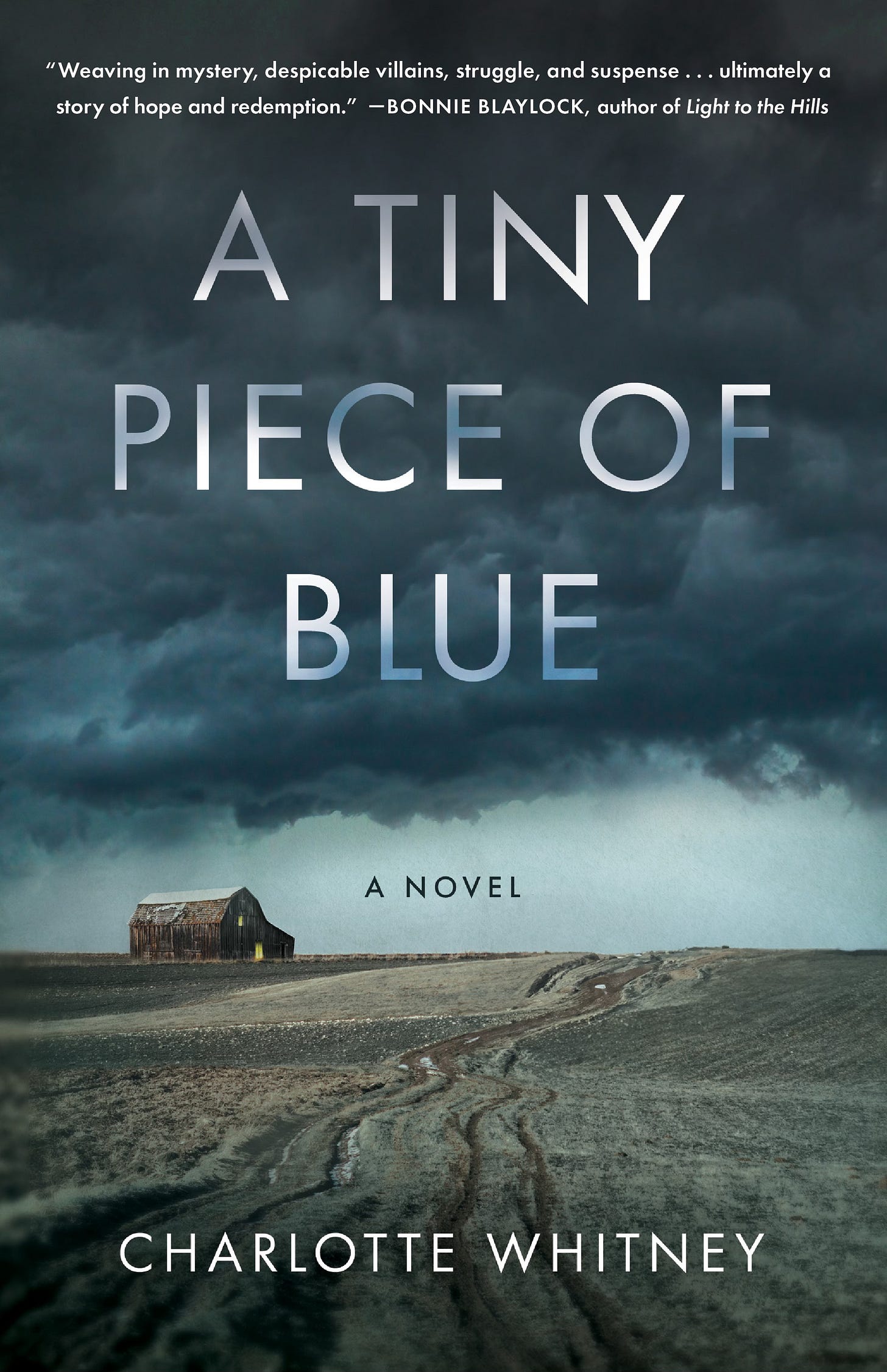Digging in with Joan Fernandez is a weekly newsletter with ideas for you on shattering limits to reaching your true potential, told through bits from the life of Jo van Gogh (the woman that would not allow Van Gogh to die twice). Please sign up here.

New growth is wobbly.
Like a fawn’s first gangly steps, in order to grab life it has no choice but to get up shortly after birth and walk.
Uncoordinated, all its bumbling awkwardness out in the open.
Stumbling forward on its own.
Yep, I’m talking about quavery me being in front of book lovers—a lot of clubs and a few groups coming to bookseller events—to hear insider scoop on writing my book, Saving Vincent.
[For those new to these essays, my book is based on a true story, Jo van Gogh, a timid widow who takes on the male-dominated art elite to save her brother-in-law Vincent’s art from obscurity. Without Jo, we would not have Vincent van Gogh’s art.]
Being public-facing is a big transition from solo writing. Prior to this, for ages (seven years!), I’ve basically spent my author days BFF’ing with my Macbook and Zoom groups of sister authors. I am an omnivert (comfortable as extrovert and introvert) but c’mon, answering questions about a story that’s been a passion project is a whole new vulnerable encounter.
Here’s what I’m learning: Embracing vulnerability can be a catalyst for growth. Instead of a weakness to be hidden, I’m finding that so far it’s a necessary step for my (and the book’s) genuine progress. Stepping outside the comfort zone of solo writing isn’t easy but it’s paying off with new insights.
All because of how cool you are.
Check out these examples.
Reciprocal Nature of Connection
Two months since launch I’ve had the opportunity to do ten events. Like that stumbling fawn, with each one I’m a bit more coordinated. Every meetup’s been different, of course, but one lovely constant about book lovers are their thoughtful, perceptive, astute questions—not to trip me up, but to genuinely explore— ideas in the book.
And when I answer the queries—guess what—my own understanding of this book deepens.
Nuts, huh? Maybe that’s proof that universal ideas like “following your heart” hold glorious individual depths.
To give you a feel for the scope of questions book lovers ask, here’s a sampling of three:
[Worldview] How factual is the book’s backdrop of French nationalism?
It’s real. Around the turn of the century, European nations’ shift of identity toward being nation-states picked up steam. We take nationalism/patriotism for granted today, but in my book I have actors react to (and attempt to take political advantage of) this new worldview. As a result, the powers-that-be make a power grab to assert only “correct” art. Its tight box was an obstacle for Vincent’s outside-the-box artistic vision to be accepted. I expressed this political worldview through a bad guy locked into the political power struggle—in turn, he blinds himself to the inevitable progress happening around him.
His example begs the question: What kinds of “exceptionalism” exist today?
[Writing Process] Since Vincent van Gogh’s letters are chockful of cool excerpts, couldn’t I have quoted more?
Tough one! I read all of Vincent’s correspondence (900 letters) As I read, I collected a notebook of quotable zingers. By the time I finished, I’d been in Vincent’s head so much that (ridiculously, I suppose) it felt like I knew him. So, I chose Vincent’s letter excerpts super intentionally.
First, to show (not tell) how Jo would come to know Vincent (post-death) in the same way I did. Her husband, Theo, was Vincent’s main correspondent and a real packrat. When Jo began to read the letters, the words brought Vincent to life for her more intimately than she’d known him in person. Secondly, I quoted Vincent at turning points in the book. The book begins after Vincent’s death; yet, he’s a pivotal character. The quotes bring his voice to the reader and, I hope, resonate, especially as they signal change ahead.
It’s been intriguing to hear favorite Van Gogh quotes—and paintings—from members of the audience.
[Story Origin] How and why did you decide on Jo as a topic?
In all ten of the events, attendees have been curious about story origin. I believe we’re all creative in some way so hearing how an idea gradually develops into an actuality is personal. For Saving Vincent, the notion to tell Jo’s story came to me after stumbling across a photo of Jo in the Van Gogh Museum. I remember staring at her small black-and-white image and wondering, “Why don’t I know you?” That moment planted a seed.
But the fuel that added fire to Jo’s example was my own professional hardshell experience spent in a professional career in industries dominated by men. Not only was Jo’s contribution to Van Gogh’s legacy almost entirely erased, but when she has appeared in a footnote, she’s been under appreciated for the hostile status quo she worked—and persisted—against.
My why was personal: Jo’s acknowledgement.
For attendees at some of the book events, it’s begged the question: What why is important to you?
Continuous Process of Discovery
So many more topics, of course: Research nuggets discovered through travel. Painful setbacks and rewrites (I wrote an entire manuscript and then started over). Fact-checking near-misses.
A big love fest exchange of favorite Van Gogh paintings.
Inevitably though, the very best part of these book discussions is when I hear readers’ self-reflection. Whether it’s about Jo’s role or their own book idea or their own life choices, hearing responses to Jo’s example and how this book came to life is a kick to witness.
So much for my book being "finished!" It feels like the book is a living entity, and each discussion uncovers new layers of meaning, new connections, and new ways of understanding the material.
I’m learning creation isn't a fixed point, but an ongoing dialogue.
And all these exchanges mean I’m walking steadier. I couldn’t be on this surer platform without the people who have taken the leap to invite me to clubs and booksellers: Elise, Kathie, Tim, Pam, Cathi, Sue, Jacqueline, Rob, Dawn and Stephanie. . .
Wouldn’t be in this space without you.
Your Invitation to Share Jo’s Story
In addition to visiting book clubs for open Q&A, I also now have a talk about Jo that sets up the book. Why Vincent’s work hadn’t caught on. Why Theo struggled to sell his art. How and why Jo could overcome the internalized expectations society had for women at the time to promote Vincent’s work. No spoilers so the talk is engaging whether listeners have read my book or not.
It’s another way to share Jo’s story.
Think you might be interested? Click the following link to say hi and your idea for spreading the word on Jo’s story: Let's Explore Sharing Jo's Story. I’ll send a book club kit (extra info and resources) to inquiries.
Other ways you can help share Jo’s story
Write a review. All it takes is a single sentence. Look up Saving Vincent, then scan and scroll to find where to add a review on your favorite bookseller site. More reviews will increase Saving Vincent’s discoverability to other book lovers.
Request my book for your local library. Public libraries have online forms for patrons to send their requests to add books to their library system collection.
Ask your local art museum or art center to add Saving Vincent to their gift shop or lending library. I love the idea of this book becoming known to art lovers.
You don’t have to be a book club to read one together! I had a great conversation with a group that plays bridge—and decided to read a book together for fun. Awesome!
I feel a bit like I’ve meandered away from my gangly-legged fawn metaphor. See what happens when people band together? Confidence. Regaining strength. Adjusting and adapting. Building momentum.
Couldn't do it without you.
Warmly,
My Book
(ah-hem) Recent Bronze Award Winner in the 2025 IPPY Book Awards in Popular Fiction
Saving Vincent, A Novel of Jo van Gogh, is about the woman that would not let Van Gogh die twice. This biographical historical novel is based on a true story.
In the early twentieth century, a timid widow—and sister-in-law of the famed painter—Jo van Gogh takes on the male-dominated art elite to prove that the hundreds of worthless paintings she inherited are world-class in order to ensure her young son will have an inheritance.
Summer Reading! Book Recommendations of Sister Award-winning Books
Gold Medal Winner for the 2025 IPPY Book Awards in Historical Fiction
Order on Charlotte Whitney's website
"A heartwarming novel following a homeless girl as she struggles to survive the Great Depression."
Set during the Great Depression, this historical novel centers on two families— in rural America a young teenage girl and a childless older couple–whose lives intersect by chance and end up forming permanent bonds. Silstice (“Silly”) becomes homeless when a fire destroys her ramshackle home and the impoverished family is forced to scatter. Against her husband Vernon’s objections, Edna Goetz takes in Silly who is a new member of her 4H sewing circle, promising the girl will only stay four weeks. But tensions mount. Rumors of unprotected youth falling prey to forced labor and prostitution by ruthless men circle ominously. Silly and her older sister Alberta worry about their missing siblings, especially younger twin brothers. With no one to rely on but themselves, the girls plot out naive plans for a better future. Danger, nefarious actors, a sudden death and more stand in the girls way up to an exhilarating climax. Whitney has written a satisfying, sweet story that celebrates themes of resilience, trust and family love. You will cheer for Silly from beginning to end.
Silver Medal Winner in the 2025 IPPY Book Awards in Historical Fiction
Order on Barbara Southard's page
"A story of love and betrayal during the Beecher-Tilton scandal and one woman’s courageous but tragic struggle against the double standard."
This taunt historical drama reads like a psychological thriller as it explores conflicting ideas introduced in the last 19th century when free love, burgeoning women’s rights and Puritan Christianity collided. Based on the true story of Elizabeth Tilton who was married to the philanderer Theodore Tilton and then accused of adultery with the famous preacher Henry Ward Beecher, the story brings to light how new societal ideas can spin out into confusing interpretations of moral behavior. At times I was convinced characters were scoundrels, victims, narcissists, manipulators, innocents, sexual predators and more. Caught in the cross-hairs, Elizabeth struggles with what’s most important. Truth? Family? Reputation? The story’s dual timeline artfully anchors the unfolding drama by looking back from the future to signal either foreboding or anticipation. With deep research, Barbara Southard has written an intriguing portrait of a consuming whirlwind of societal change through the focal point of a woman long forgotten, especially in the shadow of Beecher. Southard gives Elizabeth’s voice justice.
That’s not all! Follow me on Bookbub for free book promos and more recommendations: at Joan Fernandez







Joan, I had no doubt that you would be as great at being an author and sharing this story as you were in your other “job.” But I also love the interaction with the audience and their questions always make me think! Can’t wait to hear the questions in August with my own book club! 💜
I love how when we thought publishing was the end when really it’s just the beginning. I love seeing you bring Jo and more of you into the world. The world needs it! Keep shining your light!